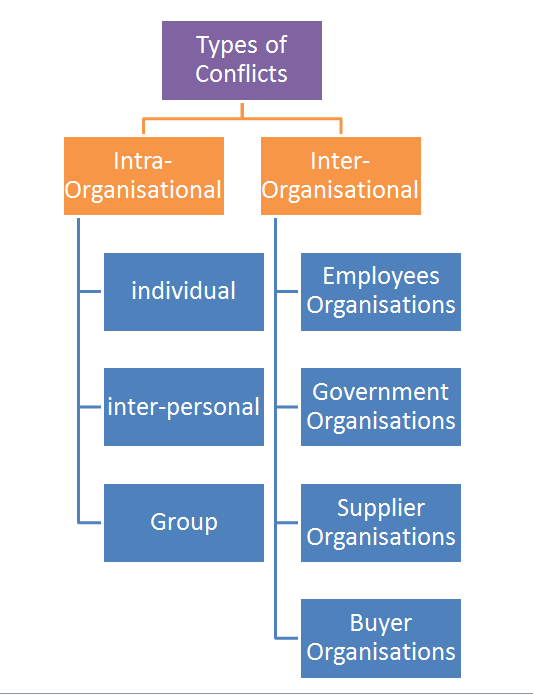What is Conflict Management – There is no one way to express or conceptualise conflict. It can be an expression of hostile feeling, negative attitude, antagonism, rivalry aggression, bickering and misunderstanding and so on. Simply stated, conflict is any tension that is experienced when a person perceives that his or her needs urges or desires are actually foiled or frustrated or likely to be foiled and frustrated.
Conflict is absence of congruity. A conflict is appearance of difference or difference of opinion or of interests. According to Professor David L. Austin, “It is a disagreement between two or more individuals or groups, with each individual or group trying to gain acceptance of its view’ of objectives over others”. When Miss Mary Parker Follet-a great management thinker defines “co-ordination” as “opposite of conflict”, one can easily define conflict is opposite of coordination.
In a nutshell, a conflict is the struggle between incompatible or struggling needs, wishes, ideas, interests of people. Conflict crops up when individuals or groups encounter goals that both parties can not attain to their fullest satisfaction.
Features Of Conflict
(1) Disagreeing Perceptions, Values and Goals – There is said to be a conflict between two or more individuals or groups when they agree to disagreed perceptions, values and goals. Stated in another way, they do not have same perception value and purpose.
(2) Failure to Choose Best Alternatives – When two individuals or groups face a problem which has alternative solutions. Inspite of easily available solutions, they are not able to pick one solution or an alternative.
(3) Conflicts are Predictable Social Phenomenon – Conflicts are capable of being predicted well in advance. When one analyses the situation or facing a problems, he can predict the disagreement over the solution. When a problem can be smelled, the solution to the problem can also be predictable.
(4) Conflict is Perceivable – The parties disagreeing must perceive as to why they are disagreeing. If they do not perceive, the same, it means that there is no conflict, but there is perfect harmony, agreeing.
(5) Conflict is Dynamic – Conflict is a dynamic process but not static. It is because, it indicates set of events. In fact conflict is made up of countless interlocking disagreeing events. One event leads to another as one doubt leads another. Conflicts are part of a system or an organisation; an organisations is a sub-system of supra-system namely environment. Hence, environmental changes are constantly taking place and having impact on organisation. Situational changes create new conflicts.
Types Of Conflicts

Intra-Organisational Conflicts
(1) Individual Conflict – Conflict can be intra-personal, where an individual’s objective and vision differ from his/her company’s overall vision. This refers to a conflict within an individual. Intra-individual conflict arises from frustration, numerous roles that demand equal attention but is riot always possible to devote, and goals having both negative and positive aspects. 3 types of Intra-individual/Intra-personal Conflict are –
- Goal conflict,
- Conflict from frustration, and
- Role conflict.
(2) Inter-personal conflict – The most basic type of conflict is inter-personal. It is between two colleagues – arising from a host of reasons ranging from differences in personality, work-style, and personal background. The conflict at the inter-personal level involves two or more individuals and is the most common and most recognized type of conflict.
In a way, all conflicts are interpersonal conflicts because most of them involve a conflict between a person in one organization or a group and another person in some other organization or a group. Every individual has a separate alternative course of action that is acceptable to him and different individuals prefer different alternatives. Sometimes the organizations also create such circumstances that two individuals find themselves in a situation of conflict.
For example, two managers could be competing for limited capital or manpower resources. The other type of conflict is disagreement over the goals and objectives of the organization. 4 primary sources of interpersonal conflict are –
- Personal Differences,
- Lack of Information,
- Role in Compatibility, and
- Environmental Stress.
(3) Intra-group Conflict – When an individual is pitted against a group and is either unwilling or unable to conform to group dynamics, he or she invariably leaves the team due to intra-group conflict.
(4) Inter-group conflict – When the conflict is inter-group, two teams are involved in a deadlock, endangering the successful completion of a project due to differences in group dynamics. Organizational conflict is the discord that arises when the goals, interests or values of different individuals or groups are incompatible and those individuals or groups block or thwart one another’s attempts to achieve their objective.
In addition to interpersonal conflict, social psychologists have been concerned about the intergroup conflict for several years. Intergroup behavior is even specifically identified as follows;
“Intergroup behavior occurs whenever individuals belonging to one group interact, collectively or individually, with another group or its members in terms of their reference group identification. Several antecedent conditions have been identified for explaining the intergroup conflict. Reasons behind the inter-group conflict are –
- Competition for Resources.
- Task Interdependence.
- Jurisdictional Ambiguity.
- Status Struggles.
Inter organisational conflicts
Inter organisational conflicts are between the organisation and outside organisations that have business relations with the organisation. These can be the suppliers organisations or suppliers, trade unions, customers both individual or organisations and the governmental organisations that make laws, enforce laws and amend the laws.


Leave a Comment